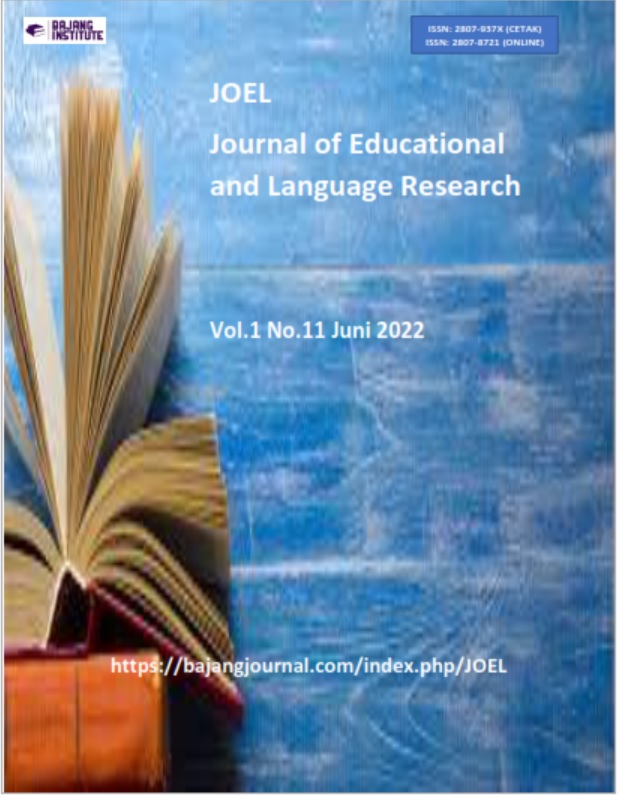PENERAPAN MODEL PEMBELAJARAN JIGSAW UNTUK MENINGKATKAN HASIL BELAJAR BAHASA INGGRIS SISWA KELAS 9.4 SMP NEGERI 4 MUARA ENIM
DOI:
https://doi.org/10.53625/joel.v1i11.2699Keywords:
Jigsaw technique cooperative learning model, English learning outcomesAbstract
This study aims to improve the reading competence of grade 9.4 students of SMP Negeri 4 Muara Enim for the 2019/2020 academic year by applying the Jigsaw technique cooperative learning model. This study applies a class action research model implemented in two cycles, each of which consists of two meetings. Each cycle applies the stages of planning, execution of actions, observation and reflection. The subjects in this study were 30 grade 9.4 students of SMP Negeri 4 Muara Enim. An indicator of the success of this study if at least 70% of grade 9.4 students can achieve scores with the Minimum Completion Criteria (KKM≥70). The results of the study in cycle II showed that with the application of the cooperative learning model, the Jigsaw technique was proven to improve student English learning outcomes. Although in the first cycle the average score achieved by students was 68.20 and only 17 students (57%) had achieved KKM≥70, but in cycle II the average score achieved was 74.10 with 22 students (73%) who had reached KKM≥70.
References
Adam, S. (2004). Using Learning Outcomes: A Consideration of the Nature, Role, Application, and Implementations for Eurupean Education of Employing “Learning Outcomes” at the Local, National, and International levels. United Kingdom Bologna seminar, 1-2 July 2004, Heriot-Watt University (Edinburgh Confrence Centre), Edinburgh. www.qualityresearchinternational.com/glossary/learningoutcomes.htm
Ali, M. (2013). Penelitian Kependidikan Prosedur dan Strategi. Bandung: CV. Angkasa.
Aronson, E., Blaney, N., Stephan, S., Sikes, J., & Snapp, M. (1978). The Jigsaw classroom. Beverly Hills, California: Sage Publication.
Chang, W. L., & Benson, V. (2020). Jigsaw teaching method for collaboration on cloud platforms. Innovations in Education and Teaching International, 1–13. doi: https://doi.org/10.1080/14703297.2020.1792332
Clement, R., Dornyei, Z., & Noels, K. (1994). Motivation, self-confidence and group cohesion in the foreign language classroom. Language Learning, 44(3), 417-448.
Deci, E., & Ryan, R. M. (1985). Intrinsic Motivation and Self-Determination in Human Behavior. New York: Plenum.
George, J. M & Jones, G. R. (2012). Understanding and Managing Organizational Behaviour. Sixth Edition. New Jersey: Prentice Hall.
Gunderson, B., & Johnson, D. (1980). Building positive attitudes by using cooperative learning groups. Foreign Language Annals, 13(1), 39-43.
Halley, J., Heiserman, C., Felix, V., & Eshleman, A. (2013). Students teaching students: A method for collaborative learning. Learning Communities Research and Practice, 1(3), 20. Retrieved from https:// files.eric.ed.gov/fulltext/EJ1112670.pdf
Ibrahim, M. dkk. (2000). Pembelajaran Kooperatif. Surabaya: University Press.
Kemendikbud. (2013). Permendikbud Nomor 68 Tahun 2013 tentang Kerangka Dasar dan Struktur Kurikulum Sekolah Menengah Pertama/Madrasah Tsanawiyah. Jakarta: Menteri Pendidikan dan Kebudayaan Republik Indonesia.
Kennedy, Eddie C. (1981). Methods in Teaching Development Reading. Hasealionis: F. E. Peachock Publisher Inc.
Komalasari, K. (2010). Pembelajaran Kontekstual Konsep dan Aplikasi. Bandung: Refika Aditama.
Kunandar (2011). Langkah-Langkah Mudah Penelitian Tindakan Kelas Sebagai Pengembangan Profesi Guru. Jakarta: Rajawali Press.
Leslie R. Nath, & Steven M. Ross. (2001). The influence of a peer-tutoring training model for implementing cooperative groupings with elementary students. Educational Technology Research and Development. Vol. 49, pages 41–56.
Lie, Anita. (2002). Cooperative Learning. Jakarta : Gramedia Widiasarana Indonesia.
Johnson, D. W. (2009). Reaching out: Interpersonal effectiveness and self-actualization, Boston: Allyn & Bacon.
Majid, A. (2013). Strategi Pembelajaran. Remaja Rosdakarya: Bandung.
Nichols, J. P., & Miller, R. B. (1994). Cooperative learning and student motivation. Contemporary Educational Psychology, Vol. 19(2), 167-178.
Rusman. (2012). Model-Model Pembelajaran. Depok. PT. Raja Grafindo Persada.
Slavin, E. Robert. (1994). Educational Psychology Theory and Practice. USA: Paramount Publishing.
Sudiran. (2017). Penelitian Tindakan Kelas: Pengembangan Profesi Guru. Tanggerang: Tirta Smart.
Sudjana, N. (2004). Dasar-Dasar Proses Belajar Mengajar. Bandung: Sinar Baru Algensido Offset.
Sugiyono. (2013). Metode Penelitian Kuantitatif, Kualitatif, dan R & D. Bandung: CV Alfabeta.
Suprihatiningrum, Jamil. 2013. Strategi Pembelajaran Teori & Aplikasi. Yogyakarta: Ar-ruzz Media.
Susanto, Ahmad. (2007).Teori Belajar dan Pembelajaran. Jakarta: Universitas Terbuka.











